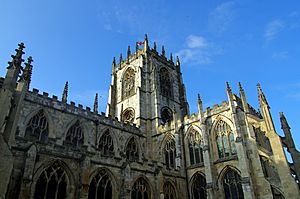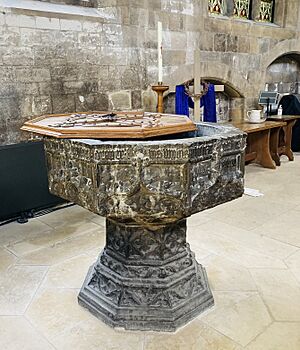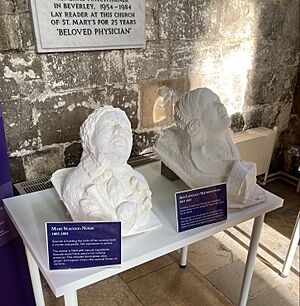St Mary's Church, Beverley facts for kids
Quick facts for kids The Parish Church of St Mary, Beverley |
|
|---|---|
 |
|
| OS grid reference | TA 03150 39805 |
| Country | England |
| Denomination | Church of England |
| History | |
| Dedication | St Mary |
| Architecture | |
| Functional status | Active |
| Heritage designation | Grade I listed |
| Designated | 1 March 1950 |
| Architectural type | Parish church |
| Style | Gothic |
| Completed | 1520 |
| Specifications | |
| Length | 197 feet (60 m) |
| Bells | 13 |
| Administration | |
| Diocese | Diocese of York |
| Province | Province of York |
St Mary's Church is an Anglican church located in Beverley, England. It is a very important historical building, recognized as a Grade I listed building. This means it is considered to be of exceptional national interest.
Contents
History of St Mary's Church
St Mary's Church began its life in the early 1100s. It was built to serve the busy trading community in Beverley. The church has a cross shape, which is called "cruciform," and is about 197 feet long. It has a main hall (nave) with side aisles, and other important parts like the chancel and transepts. There is also a tower where the main parts of the church meet.
Early Building and Changes
Some very old pieces of the church, from the 1100s and early 1200s, can still be found today. By the mid-1200s, the church had a main hall with aisles and other sections. It also likely had a tower in the middle.
Big rebuilding projects started in the late 1200s. During this time, a large chapel was added to the east side of the north transept. Around 1300, a south aisle was added to the chancel, and the east aisle of the south transept was made wider. The aisles of the main hall were completely rebuilt in the early 1300s.
In the 1330s or 1340s, the chancel got a north aisle. Three parts of this new aisle were turned into a beautiful chapel. It had special window designs called "Flowing tracery" and a unique star-shaped ceiling vault. The designs on the windows and ceiling all blended together, making the space feel very connected.
Building Stops and Resumes
Building work at St Mary's stopped in the mid-1300s. This happened in many places across England because of the Black Death, a terrible plague. Work did not start again until around 1400. At this time, the front of the church was rebuilt in a style called "Perpendicular." A row of windows high up in the nave, called a clerestory, was also added.
In the early 1400s, a south porch and a clerestory for the chancel were built. The transepts were rebuilt with their own clerestories in the mid-1400s. Old arches were reused, but they were placed on new supports. People left money in their wills between 1451 and 1453 to help with this work. More money was given between 1498 and 1500 to rebuild the west end of the nave aisles.
During the 1400s and early 1500s, beautiful wooden ceilings were also installed. The most famous one is in the chancel. It was originally from the mid-1400s but was completely repainted in 1863. It shows pictures of forty English kings, from the mythical Brutus to Henry VI. A portrait of George VI was added in 1939.
Tower Collapse and Rebuilding
On April 29, 1520, during an evening church service, the central tower of St Mary's collapsed. It fell onto parts of the church and hurt some people inside. Much of the work on the eastern end of the nave was destroyed. However, the aisle walls were not badly damaged.
The central tower, along with the nave arcades (rows of arches) and clerestory, had to be completely rebuilt. The windows in the new clerestory looked like they were from around 1400. This suggests they might have been reused, even after the tower fell. The rebuilding started right after the collapse. The south arcade even has the date 1524 carved into it.
William Rokeby, who was an Archbishop, left £200 in his will to help with the rebuilding. People who gave money for the north arcade are remembered with carvings. These include a merchant named John Crossley and his wife, the "good wives of Beverley," and five minstrels. The minstrels are shown as statues on corbels (supports) near their pier.
The church's font, which is used for baptisms, was made in 1530. It was a gift from William Leryffax, a cloth merchant from Beverley. This font is made of Derbyshire marble and has many beautiful decorations.
19th Century Restorations
In the 1800s, St Mary's Church underwent major restoration work. This work started in 1829–1830 under William Comins. Later, famous architects like A. W. N. Pugin and George Gilbert Scott also worked on the church. They helped to refit the nave and chancel, making them look new again. Many other architects also contributed to these important restorations.
Modern Carvings and Women's History
In 2020, restoration work began on the church's stonework. Some old, worn-out stone carvings were replaced with new ones. These new carvings feature characters from The Chronicles of Narnia books by C. S. Lewis.
In 2021, the church announced a special project to celebrate women. As part of the stonework restoration, new stone figures of nine important women were planned. These figures include Amy Johnson, a pilot and engineer from Hull, and Hilda Lyon, an aeronautical engineer who went to school in Beverley. Other figures include Mary Wollstonecraft, Mary Seacole, Marie Curie, Rosalind Franklin, Helen Sharman, Ada Lovelace, and Queen Elizabeth II.
The Organ
The church has a long history with its organ. In 1792, an organ built by Donaldson of York was placed in the church. It cost £311, which was raised by people giving money.
In 1869, a new organ was built by Forster and Andrews. It had a beautifully carved oak screen and decorated pipes. In 1889, the same company added a separate control panel for the organist and improved its internal workings.
In 1908, the organ was completely rebuilt by Lewis & Co. The old oak case was removed. In 1954, a local company, Hall & Broadfield, did a major overhaul. They changed the way the organ worked and turned it from a three-manual organ into a four-manual instrument. The rebuilt organ was officially dedicated in 1957.
See also



